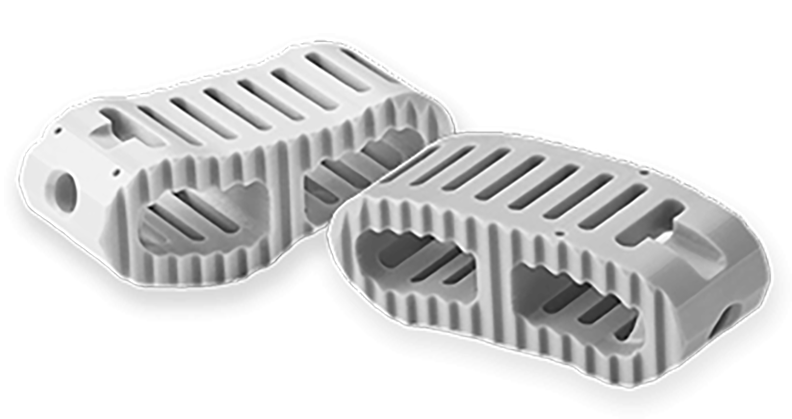
In response to spine surgeons’ shift away from traditional PEEK cages, materials were (again) one of the main themes discussed at the North American Spine Society Annual Meeting. Most device companies have responded to surgeon voices by launching cages made of titanium-coated PEEK, complete titanium, additively-manufactured titanium and even porous PEEK. In short, this trend has been spurred by the desire for a material with greater strength and bone-ingrowth capabilities.
Our conversations with surgeons and device companies lead us to restate that the materials space will spur innovation in spine. It could be a decade or more before new materials are proven through patient outcomes and surgeon adoption. At NASS, we sat down with representatives from two companies, DiFusion Technologies and MiRus, that are taking different approaches to materials. Both expect to launch products in 2018.
ZFUSE Osteoconductive PEEK
DiFusion Technologies added zeolite molecules to Solvay’s Zeniva ZA-500 PEEK to change the material to a negatively-charged substance that cultivates osteoconduction while preserving the polymer’s visualization, modulus and strength benefits. As the company’s President and CEO Derrick Johns says, they’ve merged the best qualities of titanium and PEEK to create ZFUSE.
DiFusion Technologies recently invested $500,000 in a sheep study. They expect to submit the data to FDA in January 2018 as part of a 510(k) submission that, once cleared, would give the company an osteoconductive and a biological fixation claim for their material. No other company can make that claim, says Johns.
DiFusion Technologies, founded in 2010, describes itself as an advanced biomaterials manufacturer and not a device company. In 1H18, the company plans to seek a strategic partner for ZFUSE.
The company’s patented process lends itself to development of bony ingrowth, antimicrobial and tissue regeneration polymers. DiFusion’s CleanFuse material, an antimicrobial PEEK, has CE Mark approval, and the company plans to first launch it in the U.S. hip and knee segments where infection prevention is more prevalent.
“We can also load strontium, magnesium and zinc into the same matrix and control how much is eluted,” Johns said. “We think that introducing other ions in this platform down the road is going to be the future of tissue regeneration. For example, we can grow collagen on the surface of this plastic by loading it with copper; the collagen cells will attract and proliferate on the surface. We’re just getting into what this platform can do.”
Molybdenum-Rhenium Alloy
MiRus, founded in 2016, is developing spinal implants using a proprietary molybdenum-rhenium alloy (MoRe) that is reportedly stronger than other alloys, and therefore uses less material.
Kornelis Poelstra, M.D., an orthopaedic and neural spine surgeon and founder of The Spine Center of Excellence at Sacred Heart Hospital in Pensacola, Florida, presented findings from use of the materials. When speaking with him, Dr. Poesltra highlighted three advantages to the material.
One is its strength and durability compared to other metals like cobalt chrome, titanium and stainless steel. MoRe is two to three times stronger than titanium or cobalt chrome and four times more durable, Dr. Poelstra says. This allows MiRus to use less metal, which leads to smaller implants and responds to the move to minimally invasive surgery.
Two, MoRe is also hydrophilic, making it friendly to bone ingrowth. “MoRe is about 60% more wettable than titanium, which has now become the standard as compared to metals we’ve used in the past,” he says. “With MoRe, when you put a drop of water on it, it doesn’t stay as a droplet; it flattens out quickly, similar to what cells will do if a cell drops on the surface.”
Three, MoRe can be shaped via additive manufacturing or subtractive manufacturing processes.
MiRus plans to target spinal and orthopaedic degeneration and deformities with its proprietary alloy. The company has developed a platform of spinal implants and surgical navigation, which it plans to begin launching in 2018.
“We are in the infancy of seeing what this metal can do,” Dr. Poelstra says. “So far, during standard tests, it outperforms cobalt chrome and titanium in every single aspect we’ve looked at—that makes it exciting for where this can go.”
CL
Carolyn LaWell is ORTHOWORLD's Chief Content Officer. She joined ORTHOWORLD in 2012 to oversee its editorial and industry education. She previously served in editor roles at B2B magazines and newspapers.




